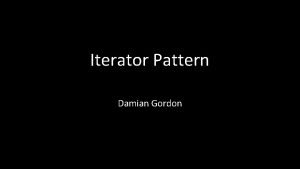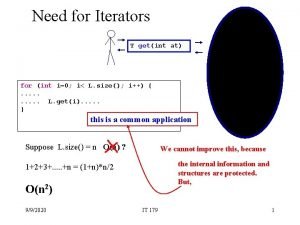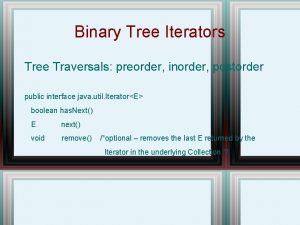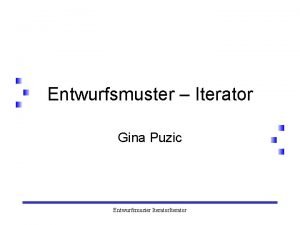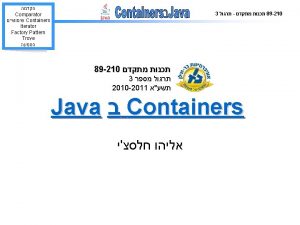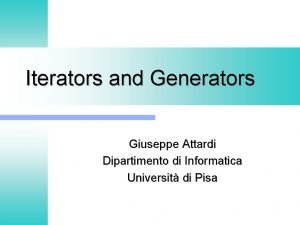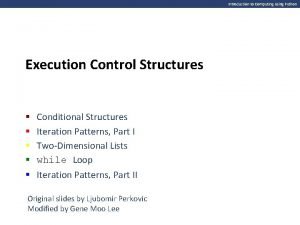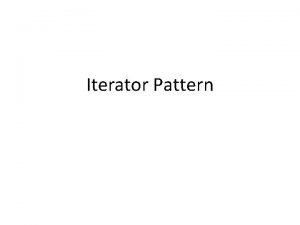Iterator Design Pattern CECS 277 Fall 2017 Mimi


















- Slides: 18

Iterator Design Pattern CECS 277 Fall 2017 Mimi Opkins

Iterator Design Pattern • This pattern is used to get a way to access the elements of a collection object in sequential manner without any need to know its underlying representation. • Iterator pattern falls under behavioral pattern category.

Diner and Pancake House Merger Objectville diner and Objectville pancake house are merging into one entity. Thus, both menus need to merged. The problem is that the menu items have been stored in an Array. List for the pancake house and an Array for the diner. Neither of the owners are willing to change their implementation.

Problems • Suppose we are required to print every item on both menus. • Two loops will be needed instead of one. • If a third restaurant is included in the merger, three loops will be needed. • Design principles that would be violated: – Coding to implementation rather than interface – The program implementing the joint print_menu() needs to know the internal structure of the collection of each set of menu items. – Duplication of code

Solution • Encapsulate what varies, i. e. encapsulate the iteration. • An iterator is used for this purpose. • The Diner. Menu class and the Pancake. Menu class need to implement a method called create. Iterator(). • The Iterator is used to iterate through each collection without knowing its type (i. e. Array or Array. List)

• Getting the menu items: Original Iteration Pancake. House. Menu pancake. House. Menu= new Pancake. House. Menu(); Array. List breakfast. Items = pancake. House. Menu. get. Menu. Items(); Diner. Menu diner. Menu = new Diner. Menu(); Menu. Items[] lunch. Items = diner. Menu. get. Menu. Items(): • Iterating through the breakfast items: for(int i=0; i < breakfast. Items. size(); ++i) { Menu. Item menu. Item= (Menu. Item) breakfast. Items. get(i) } • Iterating through the lunch items: for(int i=0; I < lunch. Items. length; i++) { Menu. Item menu. Item = lunch. Items[i] }

Using an Iterator • Iterating through the breakfast items: Iterator iterator = breakfast. Menu. create. Instance(); while(iterator. has. Next()) { Menu. Item menu. Item = (Menu. Item)iterator. next(); } • Iterating through the lunch items: Iterator iterator = lunch. Menu. create. Iterator(); while(iterator. has. Next()) { Menu. Item menu. Item = (Menu. Item)iterator. next(); }

Iterator Design Pattern • The iterator pattern encapsulates iteration. • The iterator pattern requires an interface called Iterator. • The Iterator interface has two methods: – has. Next() – next() • Iterators for different types of data structures are implemented from this interface.

Class Diagram for the Merged Diner

Using the Java Iterator Class • Java has an Iterator class. • The Iterator class has the following methods: – has. Next() – next() – remove() • If the remove() method should not be allowed for a particular data structure, a java. lang. Unsupported. Operation. Exception should be thrown.

Improving the Diner Code • Changing the code to use java. util. iterator: – Delete the Pancake. House. Iterator as the Array. List class has a method to return a Java iterator. – Change the Diner. Menu. Iterator to implement the Java Iterator. • Another problem - all menus should have the same interface. – Include a Menu interface

Class Diagram Include Menu Adding the Menu interface

Iterator Pattern Definition • Provides a way to access elements of a collection object sequentially without exposing its underlying representation. • The iterator object takes the responsibility of traversing a collection away from collection object. • This simplifies the collection interface and implementation. • Allows the traversal of the elements of a collection without exposing the underlying implementation.

Iterator Pattern Class Diagram

Some Facts About the Iterator Pattern • Earlier methods used by an iterator were first(), next(), is. Done() and current. Item(). • Two types of iterators: internal and external. • An iterator can iterate forward and backwards. • Ordering of elements is dictated by the underlying collection. • Promotes the use of “polymorphic” iteration by writing methods that take Iterators as parameters. • Enumeration is a predecessor of Iterator.

Design Principle • If collections have to manage themselves as well as iteration of the collection this gives the class two responsibilities instead of one. • Every responsibility if a potential area for change. • More than one responsibility means more than one area of change. • Thus, each class should be restricted to a single responsibility. • Single responsibility: A class should have only one reason to change. • High cohesion vs. low cohesion.

Iterators and Collections • In Java the data structure classes form part of the Java collections framework. • These include the Array. List, Vector, Linked. List, Stack and Priority. Queue classes. • Each of these classes implements the java. util. Collection interface which forces all subclasses to have an iterator() method. • The Hashtable class contains keys and values which must iterated separately.

Credits • http: //titancs. ukzn. ac. za/Homepage. aspx
 Polymorphism animal example
Polymorphism animal example Cecs 277
Cecs 277 The fire dragon species implements the reptile interface
The fire dragon species implements the reptile interface Cecs 277
Cecs 277 Cecs 277
Cecs 277 Cecs 277
Cecs 277 Iterator design pattern python
Iterator design pattern python Iterator inner class java
Iterator inner class java Inorder iterator
Inorder iterator Rapid json github
Rapid json github Iterator entwurfsmuster
Iterator entwurfsmuster Comparator design pattern
Comparator design pattern Volcano iterator model
Volcano iterator model Zig iterator
Zig iterator Informatica def
Informatica def Code blocks in python
Code blocks in python Cecs 323
Cecs 323 Cecs 474
Cecs 474 Cecs 474
Cecs 474






